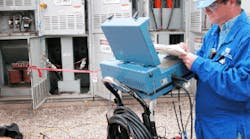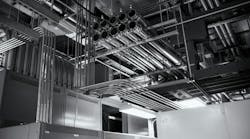We hear it all the time — America’s electrical infrastructure is aging. Coupled with that reality, one of the issues that continues to surface around this ongoing discussion is knowing the reliability of the nation’s complex medium-voltage (MV) power cable infrastructure, given the fact that the total picture is ultimately unknown. Although this is a valid concern, recent technological advances have made the assessment of electric utility and commercial electrical power systems much less labored and complicated. With that being said, assessing service-aged, MV power cables (see What Is a Service-Aged Cable?) continues to be a touchy subject among many in the industry — with testing and data analysis methodologies, test equipment manufacturers, frequency of testing, and qualifications of the testing organizations elevating the controversy.
By identifying the electrical stress points and quantifying their severity, the facility engineer can determine the aging and failure mode that will cause degradation or other damage that, over time, could lead to the ultimate failure of a cable system. He or she can then use this information to select the most effective methodology of inspection and testing techniques for detecting and monitoring the anticipated aging/failure mode.
Life expectancy
MV power cables are qualified by various manufacturers to provide a specified life of anywhere from 20 to 30 years of continued service in optimal environmental and operating conditions. Many of the MV power cables operating in commercial, electric utility, and industrial locations can be exposed to a variety of environmental and operational stressors, including elevated temperature, high UV radiation, high humidity, water submersion, and exposure to dust, dirt, and corrosive contaminants.
Electromechanical forces resulting from the passage of high levels of short circuit current through a power cable can potentially cause mechanical damage to cable jacket and insulation material and cable conductors. High-voltage stress from lightning strikes or power system transients can also degrade the dielectric strength of cable insulation. Over time, these stressors — or combinations of stressors — can cause aging and areas of insulation stress points that will result in a gradual degradation of the cable insulation and jacket materials.
Although these failure modes and anomalies sound depressing and may be somewhat concerning, rest assured that the majority of existing cable infrastructure in the United States has exceeded 40 years of service life.
Failure modes
For cables that do fail early, their demise can typically be attributed to one of the following failure modes:
Partial discharge — A localized electrical discharge that only partially bridges the insulation between conductors and may or may not occur adjacent to a conductor. This phenomenon causes excessive heating and degradation of the cable insulating materials as well as ionization of the air in the vicinity of the current leakage. If not corrected, this failure mode could catastrophically degrade into one or both of the next two failure modes.
Treeing — A name commonly given to the tree-like erosion propagated by electrical discharges in a cable insulation or covering. Electrical treeing is defined as tree-like growths, consisting of nonsolid or carbonized micro-channels, which can occur at stress enhancements, such as protrusions, contaminants, or voids subjected to electrical stress for extended time periods. Water treeing is the result of chemical modifications in the presence of moisture that can occur at stress enhancements, such as protrusions, contaminants, or voids in polymeric materials subjected to electrical stress and moisture.
Poor workmanship — Direct mechanical damage, such as bending, abrasion, cutting, contact, deformation, and perforation (resulting from installation and maintenance activities in and around the location of a cable), is a potential point of failure. Cable splices are exposed to the same environmental and operational stresses as the cables on which they are installed. Because cable splices are constructed of many of the same or similar materials as the electric cables on which they are installed, these stressors can also cause aging degradation of the polymer insulating materials used in the cable splice. In addition, the other subcomponents that make up a cable splice (insulating tape, fillers, sleeves, insulating compounds, and compression connectors) are also susceptible to aging degradation. A poorly installed or designed splice can result in multiple penetration pathways for moisture into the interior of the splice — not only around the splice materials where they about the surface of the cable insulation, but also through the damaged or cracked outer jacket or insulation.
Maintenance planning
A facility maintenance planner must really do his or her homework to justify the need to test the lifeline of the electrical power system — the MV power cable. Performing scheduled periodic maintenance on the electrical systems’ circuit breakers, switchgear, protective relaying, and transformers is somewhat less complicated and time consuming than planning a long-duration outage to perform testing and assessment on the power cables. Financial pressures within facilities have made it difficult to shut them down to implement off-line power cable testing methodologies. Fortunately, newer technologies exist that may help us extend the cable assessment windows further out (months or, in some cases, years) with interim lower-cost online testing in between the off-line maintenance testing cycles. Cable testing can increase the outage duration and labor cost of an outage; however, if performed correctly, it can yield valuable data about the aging process of the MV power cables.
Technicians performing electrical tests and inspections should be trained and qualified to understand the hazards associated with operating, switching, and maintaining electrical power equipment. These individuals must also be trained, experienced, and capable of conducting the cable testing, evaluating the test data, and making an informed judgment on the continued serviceability or non-serviceability of the cables under test.
Time-based preventive maintenance model
The decision to take an outage for a time-based preventive maintenance approach will require much planning to identify specific cable sets to test, inspect, and analyze. This planning will require as much historical information about the construction and maintenance of the facility as possible, including one-line diagrams and manufacturer data on the cables to be tested.
The primary goal of any preventive maintenance plan for MV power cables is to test and analyze the overall insulation of the cable as well as to determine the serviceability of the accessories through data trending to prevent catastrophic failures. Therefore, many decisions about the testing methodology will have to be made, which is where the controversy begins.
Because many of the available diagnostic tests must be performed when the equipment is off-line, de-energized, and disconnected from service, understanding the methodology and the pros and cons associated with each test method is important.
DC hi-potential testing — This method relies on a source of high DC voltage for the testing of cables and other types of electrical equipment.
- Pro — The DC hi-pot test is a simple, extremely portable, and relatively inexpensive piece of test equipment to purchase and operate. Because it’s a simple pass or fail procedure, low skill sets are required to perform the test, plus it’s the least costly of any of the methodologies.
- Con — The DC hi-pot test can be a destructive test when performed on service-aged, MV cable insulation (as per an EPRI study performed in the 1990s). This test methodology is also blind to certain types of insulation defects and induces space charges that can aggravate existing insulation defects in aged extruded cables. The EPRI study also showed that continued DC testing of serviced-aged, MV cables can accelerate the aging process of the cables. Atmospheric conditions, such as moisture and wind, can also affect leakage current readings.
AC hi-potential testing — This method uses AC high voltage for the testing of cables and other types of electrical equipment at a level greater than the rated voltage of the tested equipment.
- Pro — The AC hi-pot test is considered a good test for conductive and high-impedance defects in cables and does not induce space charge. Continued use generally does not create additional aging effects. It is widely used to replicate steady-state AC service conditions and the original factory over-potential test.
- Con — The AC hi-pot test requires a much larger power source than its DC counterpart and comes with an inherent need for multiple personnel at times, which makes it the most costly test to run. Although this AC test can accelerate the aging process of the cables, it typically does so at a much slower rate than DC. This test is generally a “go” or “no go” test.
Very low-frequency (VLF) testing — This test uses an instrument similar to an AC over-potential test set but uses a much lower output frequency than standard AC over-potential test sets.
- Pro — The VLF test is a simple, extremely portable, and relatively inexpensive piece of test equipment to purchase and operate with low power requirements. It is considered a good test for conductive and high-impedance defects in cables and does not induce space charge. Continued use generally does not accelerate or create additional aging effects after the test is administered; however, some existing defects may grow rapidly, making the test time short.
- Con — The VLF methodology has a relatively short history of usage and is just becoming commonplace in the field. This methodology can aggravate existing insulation defects in aged extruded cables. IEEE 400.2 standards caution against use on service-aged cables with multiple defects. The elevated voltage levels could cause the defects to bridge together. Generally a “go” or “no go” test, the VLF test does not replicate service conditions or factory tests and is considered a destructive test.
Power factor/dissipation factor testing — Insulation power factor is the ratio of true power to apparent power. When multiplied by 100, it is referred to as the “percent power factor.” The power factor of the leakage current in an MV power cable provides information about the quality of the overall cable insulation.
- Pro — In use for more than 75 years, the power factor test is one of the most common tests performed on electrical apparatus to determine condition of the solid insulation. Although the technology has evolved rapidly over the last 25 years, it’s still based on the same basic concept.
- Con — The test set is moderately expensive, and longer runs of cable will require additional equipment, such as resonators, to extend the cable testing range. In addition, the power factor test requires baseline or previous power factor test data to trend the results. This methodology has the ability to detect localized insulation defects, but defects that are voltage dependent may not be detected if the initiation voltage of the defect is greater than the test voltage. Insulation resistance decreases as the inherently normal dielectric-loss and capacitance of the systems increases.
VLF dissipation factor testing — Also known as “tan delta” testing, this test is performed by applying a voltage below the operating voltage and then retesting at a voltage slightly above the operating voltage.
- Pro — The tan delta is a simple, extremely portable, and relatively inexpensive piece of test equipment to purchase and operate. This methodology is non-destructive when using voltages up to 10% to 20% over the normal operating range and very effective/widely used for identifying water trees in extruded cables. The test is a true diagnostic test, allowing the operator to gain signature data about the condition of the cable insulation.
- Con — Tan delta results at 60 Hz can present inaccurate cable insulation assessments results, specifically on highly service-aged power cables. Test durations are longer for each individual conductor compared to other test methodologies.
Off-line partial discharge testing — Known as “off-line PD testing,” this test assesses the power cables’ insulation and accessories, identifying electrical trees, contamination, de-lamination, and other physical precursors to failure.
- Pro — This test has a relatively short history of usage and is just recently becoming commonplace in the field. This methodology is capable of testing up to 3 miles of power cable, with some limitations due to construction type and conductor sizing. The test monitors cable insulation response during voltage application and accurately locates splices, joints, irregularities, and exact PD locations on a conductor. The test is effective with mixed dielectric conductors.
- Con — The off-line PD test is limited to power cables with continuous metallic shields, requires extensive outages for multiple sets of cable, and is the most costly to perform compared to other methodologies. The technology is still somewhat of a controversial subject in the testing arena due to the requirement that the data typically has to be analyzed off-site or by personnel other than those performing the test. In addition, some experts question whether the test is repeatable between testing cycles.
Time-based predictive maintenance program
When an electrical outage is cost prohibitive or lacks internal support, a time-based predictive maintenance approach may be the answer. This maintenance strategy involves the process of evaluating the condition of equipment by performing periodic or continuous (online) equipment condition monitoring. Basically, predictive maintenance differs from preventive maintenance by basing the maintenance need on an assessment of the actual condition. However, it can also be based off of a preset schedule. There is one key test method used with this approach.
Online partial discharge testing — The “online PD test” is performed while the equipment is energized at normal operating voltages and provides a snapshot-in-time sample, which is pulled and sent to a third-party laboratory for analysis.
- Pro —This test is conducted under real operating conditions — at typical temperatures, voltage stress levels, and vibration levels. It’s a non-destructive test and doesn’t use overvoltages that could adversely affect the equipment. Online PD testing is relatively inexpensive compared to off-line testing, which requires interruption of service and production. This methodology detects and locates some accessory and a few cable defects, but can also detect failures in other areas (i.e., switchgear and bus).
- Con — Online PD testing is not calibrated; test results are not objective and have no comparable data to factory tests or IEEE standards. Like off-line PD testing, this technology is still somewhat of a controversial subject in the testing arena due to the requirement that the data typically has to be analyzed off-site or by personnel other than those performing the testing. In addition, some experts question whether the test is repeatable between testing cycles.
Overview
As MV power cables continue to age, pushing well past their initial design and installation specifications, a blend of qualified tests will be needed to trend the aging process and assess remaining useful life.
DC overpotential testing of service-aged, MV cables is no longer the most desired methodology. AC over-potential and AC VLF testing, which can grow some inherent insulation defects and have a somewhat destructive nature, seem to be losing favoritism with many facility owners. Online PD testing is beginning to provide small snapshots of crucial information on the integrity of an electrical system. Partial discharge can be located, measured, and recorded, helping to identify cables, switchgear, and even transformers that are close to failure in between routine testing cycles.
The blending of multiple methodologies seems to offer the best information on the health and aging progress of MV power cables. Possible combinations for service-aged cables could include annual online PD sampling and analysis followed by three-year to five-year off-line maintenance intervals using power factor/dissipation factor testing or tan delta/dissipation factor testing.
Regardless of the methodology chosen, it appears there will be no shortage of controversy among the testing community. In the end, most testing contractors are looking to offer a qualified, repeatable, non-destructive approach to trending and analyzing electrical power cable insulation and accessory data for their customers.
Moore is a vice president with Shermco Industries in Dallas. He can be reached at [email protected].




